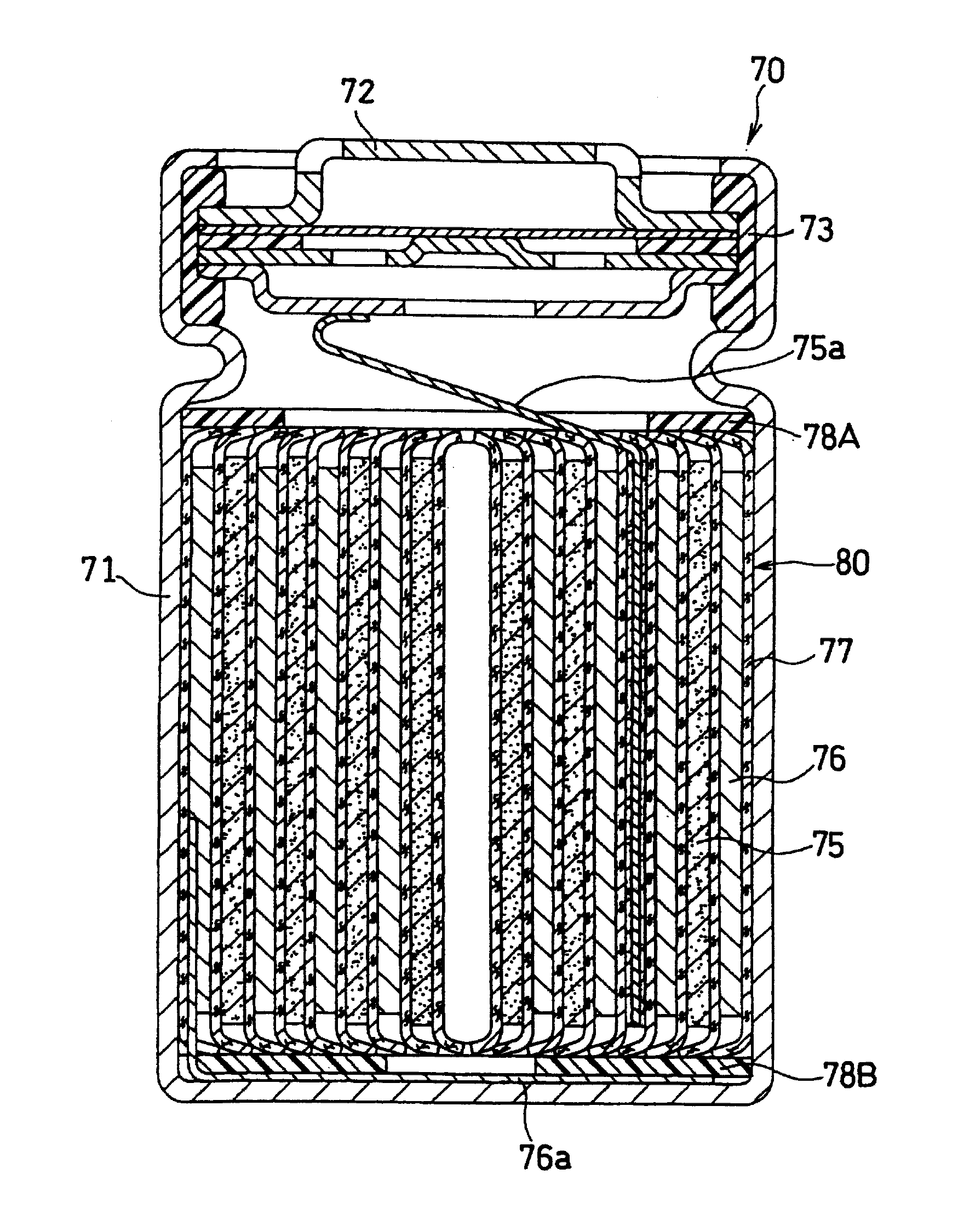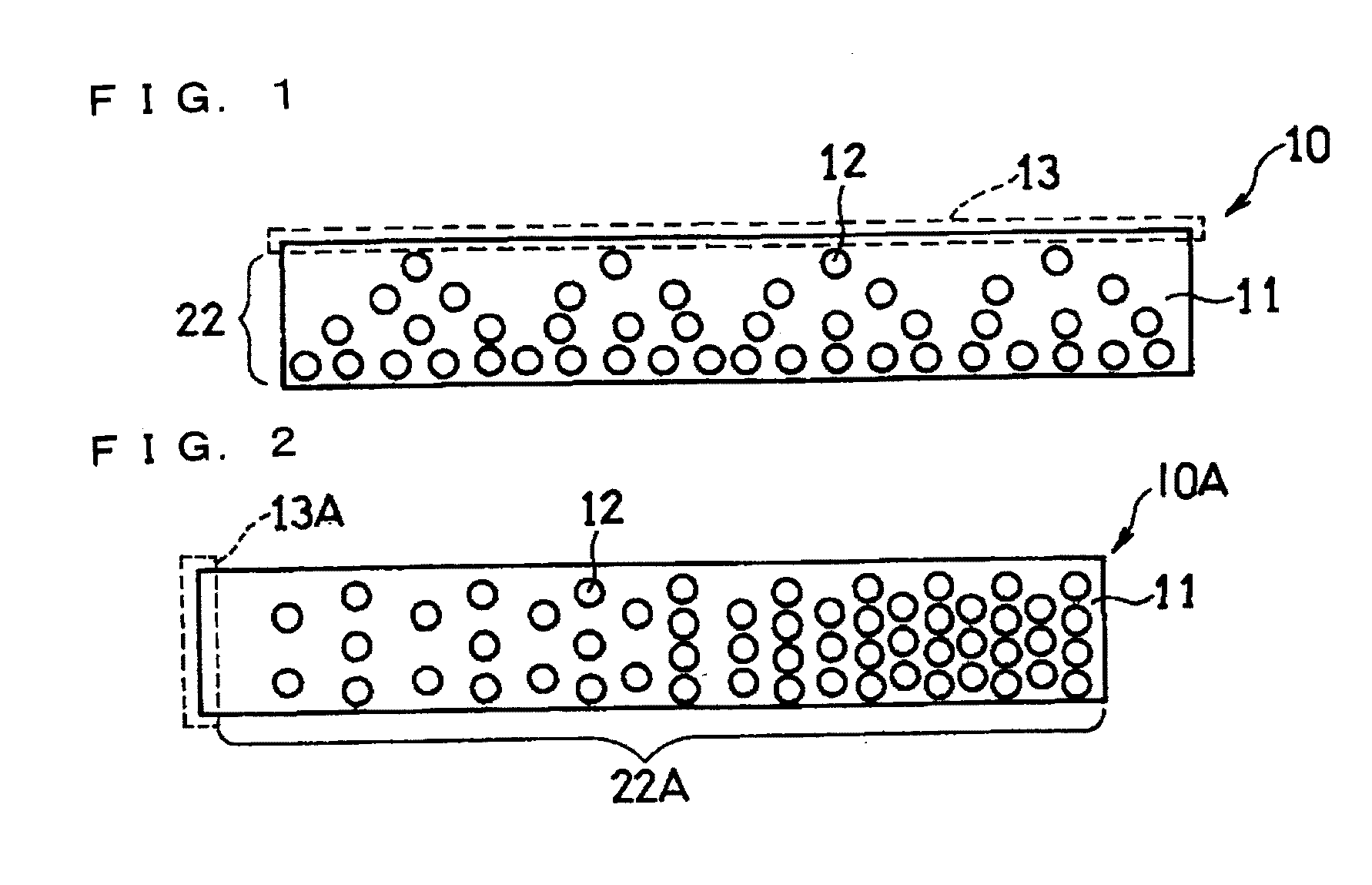Current collector for non-aqueous electrolyte secondary battery, electrode, non-aqueous electrolyte secondary battery, and method for producing the same
a technology of non-aqueous electrolyte secondary batteries and current collectors, which is applied in the direction of cell components, final product manufacturing, sustainable manufacturing/processing, etc., can solve the problems of difficult utilization of ptl 1 technique, difficult work of thin metal foils, and gradual change of thickness, so as to reduce the difference in current density between the distant and the close region, prevent the promotion of deterioration of active materials, and reduce the amount of heat.
- Summary
- Abstract
- Description
- Claims
- Application Information
AI Technical Summary
Benefits of technology
Problems solved by technology
Method used
Image
Examples
embodiment 1
[0037]FIG. 1 is a schematic plan view of the structure of a current collector for a non-aqueous electrolyte secondary battery according to Embodiment 1 of the invention.
[0038]A current collector 10 illustrated therein comprises a metal foil 11 having a rectangular shape. The metal foil 11 has a plurality of through-holes 12 in a predetermined arrangement.
[0039]The current collector 10 has one end 13 in the width direction, to which an electrode lead (not shown) is attached. That is, the one end (long-side end) 13 of the current collector 10 in the width direction is a portion to be connected to an external terminal where the current is concentrated. The other portion of the current collector 10 is a current collection region 22 where an active material is supported. As used herein, a rectangular shape refers to a shape having a pair of long-side ends and a pair of short-side ends.
[0040]With respect to the arrangement of the through-holes 12, it is preferable to form the through-hole...
embodiment 2
[0053]Next, Embodiment 2 of the invention is described.
[0054]FIG. 2 is a schematic plan view of the structure of a current collector for a non-aqueous electrolyte secondary battery according to Embodiment 2. In FIG. 2, the same components as those of FIG. 1 are given the same reference characters.
[0055]A current collector 10A illustrated therein also comprises a rectangular metal foil 11 and the metal foil 11 has a plurality of through-holes 12, in the same manner as the current collector 10 of FIG. 1. The current collector 10A is different from the current collector 10 of FIG. 1 in that an electrode lead (not shown) is attached to one end (short-side end) 13A in the longitudinal direction. That is, the one end 13A of the current collector 10A in the longitudinal direction is the portion to be connected to an external terminal. The other portion of the current collector 10A is a current collection region 22A where an active material is supported.
[0056]In the current collector 10A, t...
embodiment 3
[0058]Next, Embodiment 3 of the invention is described. FIG. 3 is a schematic plan view of the structure of a current collector for a non-aqueous electrolyte secondary battery according to Embodiment 3. In FIG. 3, the same components as those of FIG. 1 are given the same reference characters.
[0059]A current collector 10B illustrated therein also comprises a metal foil 11 and the metal foil 11 has a plurality of through-holes 12, in the same manner as the current collector 10 of FIG. 1. The current collector 10B is different from the current collector 10 of FIG. 1 in that an electrode lead (not shown) is attached to a middle portion 13A in the longitudinal direction. That is, the middle portion 13B of the current collector 10B in the longitudinal direction is the portion to be connected to an external terminal. The other portion of the current collector 10B is a current collection region 22B where an active material is supported. In the current collector 10B, the current collection r...
PUM
| Property | Measurement | Unit |
|---|---|---|
| size | aaaaa | aaaaa |
| thickness | aaaaa | aaaaa |
| size | aaaaa | aaaaa |
Abstract
Description
Claims
Application Information
 Login to View More
Login to View More - R&D
- Intellectual Property
- Life Sciences
- Materials
- Tech Scout
- Unparalleled Data Quality
- Higher Quality Content
- 60% Fewer Hallucinations
Browse by: Latest US Patents, China's latest patents, Technical Efficacy Thesaurus, Application Domain, Technology Topic, Popular Technical Reports.
© 2025 PatSnap. All rights reserved.Legal|Privacy policy|Modern Slavery Act Transparency Statement|Sitemap|About US| Contact US: help@patsnap.com



